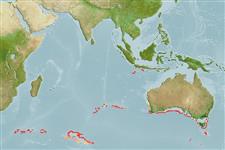Elasmobranchii (tubarões e raias) (sharks and rays) >
Carcharhiniformes (Ground sharks) >
Pentanchidae (Deepwater catsharks)
Etymology: Apristurus: a-, Latin privative, i.e., without; pristis, from pristes (Gr.), sawyer (but here meaning saw); oura (Gr.), tail, referring to absence of saw-toothed crest of enlarged dermal denticles along upper edge of caudal fin as found in the closely related Pristiurus (=Galeus). (See ETYFish); bucephalus: bu- (L.), prefix meaning large; cephalus, from kephale (Gr.), head, referring to its large, broad head. (See ETYFish).
More on authors: White, Last & Pogonoski.
Environment: milieu / climate zone / depth range / distribution range
Ecologia
marinhas batidemersal; intervalo de profundidade 1030 - 1140 m (Ref. 76944). Deep-water
Eastern Indian Ocean: Western Australia.
Tamanho / Peso / Idade
Maturity: Lm ? range ? - ? cm
Max length : 67.5 cm TL (female)
Descrição suscinta
Morfologia | Morfometria
This moderately-large species has the following characters: labial furrows of upper and lower subequal in length; relatively short preorbital snout; very robust head, its width (at mouth corners) 13.9% TL; large mouth, its width 11.1% TL; large orbit, its length 3.7% TL; relatively long length of prepectoral and prepelvic; first dorsal fin is slightly smaller than second one, its origin well forward of pelvic fin insertion; tall anal fin, short based, triangular in shape; widely spaced dermal denticles, moderately large, deciduous, with long medial cusps; species size to at least 67.5 cm TL; uniformly medium yellowish brown body and fins ; about 66 teeth rows in upper jaw, about 55 rows in lower jaw; adult female teeth with 5 cusps, 1 very long medial cusp, 2 much shorter inner lateral cusps, 2 much shorter outer lateral cusps situated anteriorly to inner lateral cusps; 35 monospondylous vertebrae; 26 diplospondylous precaudal vertebrae; about 108 total vertebrae (Ref. 76944).
Ciclo de vida ou comportamento de acasalamento
Maturidade | Reprodução | Desova | Ovos | Fecundidade | Larvas
White, W.T., P.R. Last and J.J. Pogonoski, 2008. Apristurus bucephalus sp. nov., a new deepwater catshark (Carcharhiniformes: Scyliorhinidae) from southwestern Australia. pp. 105-111. In P.R. Last, W.T. White and J.J. Pogonoski (eds). Descriptions of new Australian chondrichthyans. CSIRO Marine and Atmospheric Research Paper no. 22. 365 p. (Ref. 76944)
Status na Lista Vermelha da UICN (Ref. 130435)
Ameaça para os humanos
Harmless
Uso pelos humanos
Mais informação
Nomes comunsSinônimosMetabolismoPredadoresEcotoxicologiaReproduçãoMaturidadeDesovaAgregação de desovaFecundidadeOvosDesenvolvimento dos ovos
Idade/TamanhoCrescimentoPeso-comprimentoComprimento-comprimentoFrequências de comprimentoMorfometriaMorfologiaLarvasDinâmica larvalRecrutamentoAbundânciaBRUVS
ReferênciasAquaculturaPerfil para aquaculturaEstirpesGenéticaElectrophoresesHereditariedadeDoençasProcessamentoNutrientsConversão de massa
ColaboradoresFotosStamps, Coins Misc.SonsCiguateraVelocidadeTipo de nataçãoÁrea branquialOtólitosCérebrosVisão
Ferramentas
Relatórios especiais
Baixar XML
Fontes da internet
Estimates based on models
Preferred temperature (Ref.
123201): 3.2 - 4.9, mean 4.4 °C (based on 17 cells).
Índice de diversidade filogenética (Ref.
82804): PD
50 = 0.5000 [Uniqueness, from 0.5 = low to 2.0 = high].
Bayesian length-weight: a=0.00355 (0.00176 - 0.00714), b=3.09 (2.91 - 3.27), in cm total length, based on LWR estimates for this (Sub)family-body shape (Ref.
93245).
Nível Trófico (Ref.
69278): 3.9 ±0.4 se; based on size and trophs of closest relatives
Resiliência (Ref.
120179): Muito baixo(a), tempo mínimo de duplicação da população maior que 14 anos (Fec assumed to be < 10).
Fishing Vulnerability (Ref.
59153): Moderate to high vulnerability (47 of 100).
